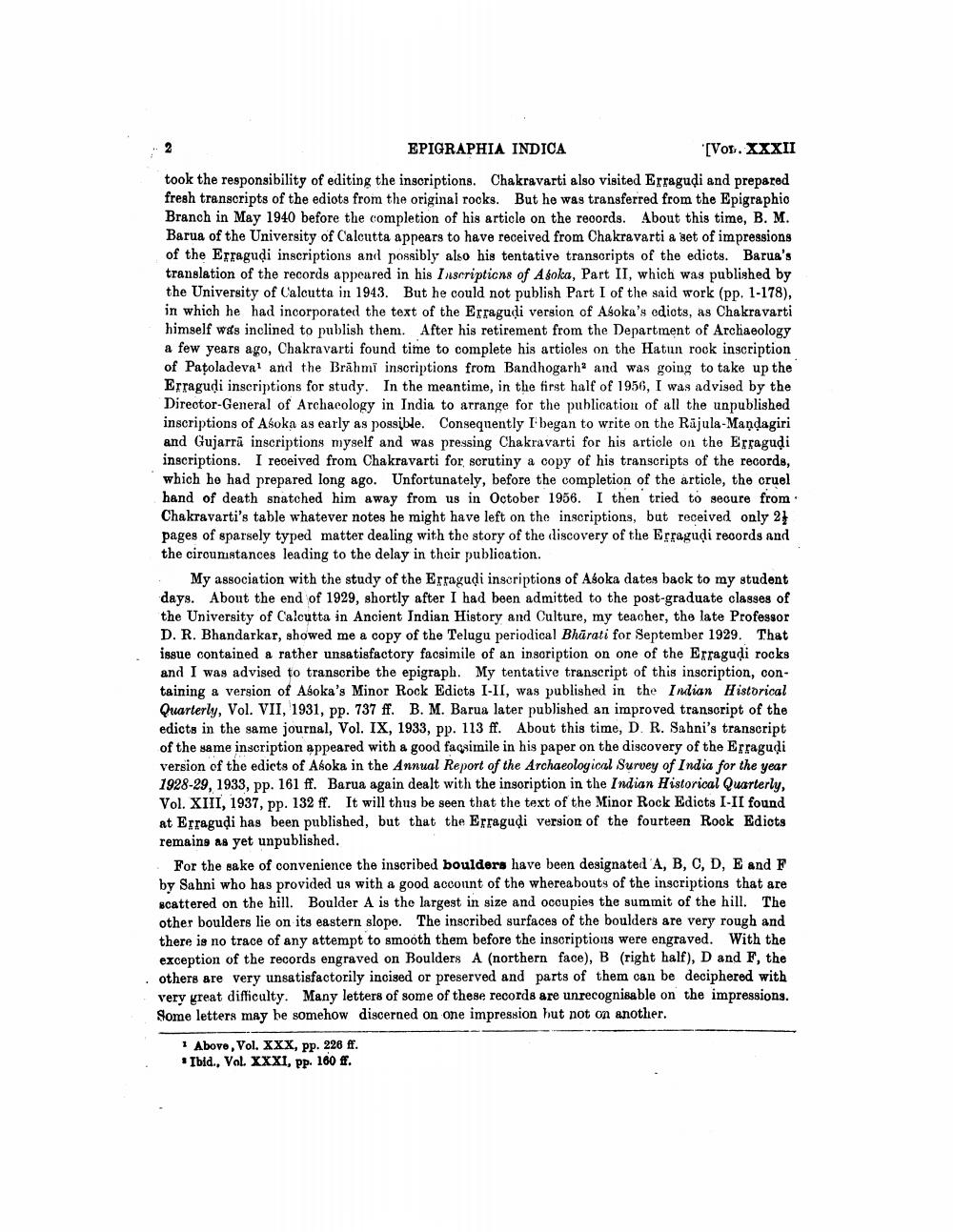________________
EPIGRAPHIA INDICA
[VOL. XXXII
took the responsibility of editing the inscriptions. Chakravarti also visited Erragudi and prepared fresh transcripts of the ediots from the original rocks. But he was transferred from the Epigraphic Branch in May 1940 before the completion of his article on the records. About this time, B. M. Barua of the University of Calcutta appears to have received from Chakravarti & set of impressions of the Erragudi inscriptions and possibly also his tentative transcripts of the edicts. Barua's translation of the records appeared in his Inscriptions of Asoka, Part II, which was published by the University of Calcutta in 1943. But he could not publish Part I of the said work (pp. 1-178), in which he had incorporated the text of the Etragudi version of Asoka's odiots, as Chakravarti himself was inclined to publish them. After his retirement from the Department of Archaeology a few years ago, Chakravarti found time to complete his articles on the Hatun rock inscription of Patoladeval and the Brāhmi inscriptions from Bandhogarh and was going to take up the Erragudi inscriptions for study. In the meantime, in the first half of 1956, I was advised by the Director-General of Archaeology in India to arrange for the publication of all the unpublished inscriptions of Asoka as early as possible. Consequently I began to write on the Rājula-Mandagiri and Gujarrā inscriptions myself and was pressing Chakravarti for his article on the Erragudi inscriptions. I received from Chakravarti for, scrutiny a copy of his transcripts of the records, which he had prepared long ago. Unfortunately, before the completion of the article, the cruel hand of death snatched him away from us in October 1956. I then tried to secure from Chakravarti's table whatever notes he might have left on the inscriptions, but received only 21 pages of sparsely typed matter dealing with the story of the discovery of the Erragudi records and the circunstances leading to the delay in their publication.
My association with the study of the Erragudi inscriptions of Asoka dates back to my student days. About the end of 1929, shortly after I had been admitted to the post-graduate classes of the University of Calcutta in Ancient Indian History and Culture, my teacher, the late Professor D. R. Bhandarkar, showed me a copy of the Telugu periodical Bhārati for September 1929. That issue contained a rather unsatisfactory facsimile of an inscription on one of the Erragudi rocks and I was advised to transcribe the epigraph. My tentative transcript of this inscription, containing a version of Asoka's Minor Rock Edicts I-II, was published in the Inlian Historical Quarterly, Vol. VII, 1931, pp. 737 ff. B. M. Barua later published an improved transcript of the edicts in the same journal, Vol. IX, 1933, pp. 113 ff. About this time, D. R. Sahni's transcript of the same inscription appeared with a good facsimile in his paper on the discovery of the Erragudi version of the edicts of Asoka in the Annual Report of the Archaeological Survey of India for the year 1928-29, 1933, pp. 161 ff. Barua again dealt with the insoription in the Indian Historical Quarterly, Vol. XIII, 1937, pp. 132 ff. It will thus be seen that the text of the Minor Rock Edicts I-II found at Erragudi has been published, but that the Efragudi version of the fourteen Rock Edicts remains as yet unpublished.
For the sake of convenience the inscribed boulders have been designated A, B, C, D, E and F by Sahni who has provided us with a good account of the whereabouts of the inscriptions that are scattered on the hill. Boulder A is the largest in size and occupies the summit of the hill. The other boulders lie on its eastern slope. The inscribed surfaces of the boulders are very rough and there is no trace of any attempt to smooth them before the inscriptions were engraved. With the exception of the records engraved on Boulders A (northern face), B (right half), D and F, the others are very unsatisfactorily incised or preserved and parts of them can be deciphered with very great difficulty. Many letters of some of these records are unrecognisable on the impressions. Some letters may be somehow discerned on one impression hut not on another.
1 Above, Vol. XXX, pp. 226 ff. * Ibid., Vol. XXXI, pp. 160 ff.




